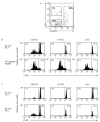CD8alpha+ dendritic cells selectively present MHC class I-restricted noncytolytic viral and intracellular bacterial antigens in vivo
- PMID: 15972648
- PMCID: PMC2778481
- DOI: 10.4049/jimmunol.175.1.196
CD8alpha+ dendritic cells selectively present MHC class I-restricted noncytolytic viral and intracellular bacterial antigens in vivo
Abstract
CD8alpha(+) dendritic cells (DCs) have been shown to be the principal DC subset involved in priming MHC class I-restricted CTL immunity to a variety of cytolytic viruses, including HSV type 1, influenza, and vaccinia virus. Whether priming of CTLs by CD8alpha(+) DCs is limited to cytolytic viruses, which may provide dead cellular material for this DC subset, or whether these DCs selectively present intracellular Ags, is unknown. To address this question, we examined Ag presentation to a noncytolytic virus, lymphocytic choriomeningitis virus, and to an intracellular bacterium, Listeria monocytogenes. We show that regardless of the type of intracellular infection, CD8alpha(+) DCs are the principal DC subset that initiate CD8(+) T cell immunity.
Conflict of interest statement
The authors have no financial conflict of interest.
Figures



References
-
- Vremec D, Pooley J, Hochrein H, Wu L, Shortman K. CD4 and CD8 expression by dendritic cell subtypes in mouse thymus and spleen. J Immunol. 2000;164:2978–2986. - PubMed
-
- O’Keeffe M, Hochrein H, Vremec D, Caminschi I, Miller JL, Anders EM, Wu L, Lahoud MH, Henri S, Scott B, et al. Mouse plasmacytoid cells: long-lived cells, heterogeneous in surface phenotype and function, that differentiate into CD8+ dendritic cells only after microbial stimulus. J Exp Med. 2002;196:1307–1319. - PMC - PubMed
-
- Shortman K, Liu YJ. Mouse and human dendritic cell subtypes. Nat Rev Immunol. 2002;2:151–161. - PubMed
Publication types
MeSH terms
Substances
Grants and funding
LinkOut - more resources
Full Text Sources
Other Literature Sources
Research Materials

